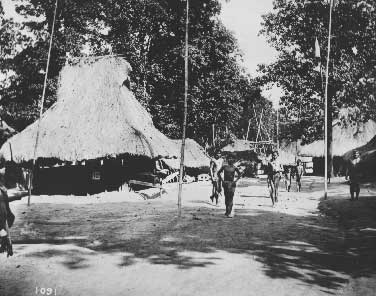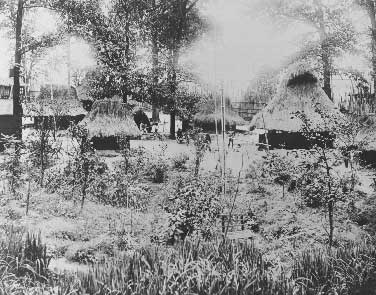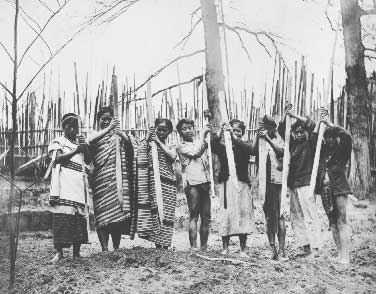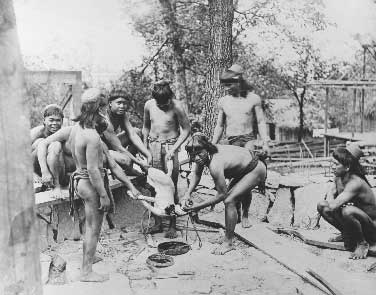Igorots Arrive in San Francisco in 1905
Historical Essay
by Elaine Elinson
Igorot Street on the Philippine Reservation at 1904 St. Louis World's Fair.
Photo: St. Louis Public Library
A headline in the San Francisco Chronicle on November 3, 1905 declares “Head-Hunting Igorrotes Here.” The article states that under the auspices of Richard Schneidewind, 25 Igorrotes – “that wild tribe of the Philippines whose ruling passion is the cutting off of human heads…have established a village after the manner of their native habitations at Central Park, on Market Street.”
The group consisted of 18 men and 7 women, including Domingo, the “venerable old savage with white hair, who is the chief of the group” and 18-year-old Watana, who now dresses in a calico skirt and an old military coat “which was probably worn by one of Uncle Sam’s soldiers while on some foray thorough her native village.
According to the Chronicle, Schneidewind “secured the sanction of the Government to bring these barbarians to America for exhibition purposes.”
And exhibit them he did. On November 4, a display ad in the Chronicle proclaims in capital letters: "Opens Today: Igorrotes – Head-Hunting, Dog-Eating Wild People from the Philippine Islands. Illustrating tribal life, manners, customs, costumes and industries during a limited engagement at Central Park, Market and Eighth, Three Gold Medals at Portland Exposition." Similar ads appeared in further editions of both the Chronicle and the Call.
“Wild Men” v. Civilization: Bringing Igorots to the U.S.
[At the end of the 19th Century,] U.S. government officials had a brilliant idea: they would bring the “wild men” of the Philippines and put them on display in the United States to show the public how crucial it was for the U.S. to “uplift and civilize” the people in the Philippines, its new colonial possession.
“This is the first and best opportunity we have had to justify,” William I. Buchanan, Director-General of the Pan American Exposition in Buffalo wrote in a letter to J.H. Brigham, Chairman of the Government Exhibition Board, in December 1899, “by means of the most available object lessons we can produce, the acquisition of a new territory, to demonstrate, as I am sure can be done, that the results to be obtained promise to be for us all ample compensation for the sacrifice already made, and for the burdens yet to be assumed.”
This was also the moment when anthropology and ethnology were in their early stages, and U.S. and European universities sent expeditions to far off lands in search of exotic and primitive people to study. Part of the impetus for the early growth of these social sciences was to establish racial hierarchies based on such flimsy evidence as head measurements and documentation of unfamiliar and poorly-understood religious and cultural rituals.
Several anthropologists had gone to the Philippines to study the tribes people of the Cordillera region Northern Luzon. In 1903, the National Geographic did a spread on the people of the region. Anthropologist Albert Jenks conducted fieldwork in 1902, and his ethnographic information was used in the brochures describing the tribes people at expositions in the U.S. Jenks, who worked for the U.S. government, brought over people from the region to the Fair, some of whom lived with him and his wife.
The government sent Frank F. Hilder to the Philippines to gather materials – such as baskets, weapons, instruments, clothing, and other artifacts for the Pan-American Exposition in Buffalo in 1901. One hundred Filipinos were brought to the fairgrounds to live in an 11-acre enclosure modeled on a Philippine village – complete with thatched huts, water buffalo pulling carts, a lake and a Catholic Church. The Buffalo Courier editorialized, “the tidings of the goodness and greatness which the Filipinos will take back will be a great help in the furtherment of the United States Government’s policy there.”
The Pan-American Exposition also included a replica of an African slave market and the belly dancer “Little Egypt – the darling of the Nile” who wowed the crowds with her “hootchy-kootchy dance.”
But the biggest splash was yet to come.
In 1904, St. Louis hosted the World’s Fair, by far the largest exposition ever. The Fair was to celebrate the centennial of the Louisiana Purchase, but the displays were also intended to enshrine ideas of racial superiority, cultural hegemony and manifest destiny. One historian called it a “self-consciously definitive event for the world’s newest colonial power.”
William Howard Taft, then governor-general of the Philippines, was quoted in the World’s Fair Bulletin as believing that the exhibit would have a “moral effect” on Filipinos and that their participation would “be a very great influence in bringing Filipinos to improve their condition.” The U.S. government spent one million dollars on the Philippine Reservation.
Igorot Village on the Philippine Reservation at the 1904 St. Louis World's Fair.
Photo: St. Louis Public Library
The visit of the Igorots to San Francisco served another purpose as well. In the 1906 edition of the American Anthropologist there is a short article by leading U.C. Berkeley anthropologist A.L. Kroeber, considered one of the founding fathers of the field of anthropology. He explains that “through the courtesy of Mr. Schneidewind” the U.C. Department of Anthropology had the opportunity to take the measurements of 18 men and 7 women from Bontoc, Tacucan and several other Igorot villages. He also made observations on the color of their skin, noting “the women gave the impression of being darker then the men.”
In the San Francisco Call on November 5 there is a disturbingly racist headline: "Igorrotes Devastate Canine Population and Nobody’s Towser is Shown Mercy." In a pathetic attempt at humor, the unsigned column states that “Fido, Towser, Jack and Bruno have taken to the pines…since the Igorrote Village erected its nipa huts in our midst.” The article includes a putative menu of the Igorrote Village, with a variety of dishes made from Skye terrier, water spaniel and Great Dane.
The last article about the Igorots in San Francisco was printed in the Chronicle on November 22 and is headlined “Handsomest Igorrote Ill with Tonsillitis.” It reports that Uguoy was admitted to the Central Emergency Hospital, accompanied by Schneidewind and Ontaro, an English speaker. The article notes that the cold weather has brought illness to the villagers and that they are planning to leave for “sunny Southern California.”
By January 14, ads begin to appear in the Los Angeles Herald for Igorrote Village at Chutes Park in Los Angeles, appearing with Chiaffarelli’s Italian Band and Professor Bilyck’s troupe of educated sea lions.
Schneidewind had signed contracts for Los Angeles Chutes Park for an exhibition advertised on handbills as “The Call of the Wild: Head-Hunting, Dog-Eating, Wild People from the Philippines.” The ads appeared in the Herald on a daily basis for several weeks. (There was a Chutes Park in San Francisco but no evidences of any performances there in the programs from any of its locations in the Haight, the Avenues or at Playland.)
Schneidewind’s contract with the 25 Igorots provided monthly salaries of $10 to older members, and lower rates to the younger members; all transportation, lodging and food. Three of the members Ontero, Felingao and Bugti signed their names to the contract, the rest were marked with an X. While in Los Angeles, three of boys, Antero, Bugti and Felingao, were enrolled in the 16th Street School. They hoped to be able to continue their studies, but by the spring they were out of school and en route to Chicago.
Other San Francisco Clues
Though the FEC group left for Los Angeles, there were a few more interesting – mentions in the San Francisco papers, each relevant in their own way. A very small item in the June 16, 1905 edition of the Chronicle, entitled “Soldiers Beat Filipinos,” is about a baseball game played on the Presidio between the “regular nine” of the Presidio and members of the Twenty-third infantry who had just returned from the Philippines and called themselves “Tagalogs.”
On May 20, 1907 the San Francisco Chronicle reports “Forty One Savages from Bontoc Province Will Give Exhibitions at the Exposition.” The exhibition they are referring to is the one across the country at Jamestown Tercentennial Exposition in Virginia [another article says no Igorrotes there – so something must have happened to them along the way].
The article reports that the group, again sponsored by Schneidewind, arrived on the Japanese steamer Nippon Maru and “despite the cold air that blew, the Igorrotes, almost naked stood about on the steerage deck of the liner and gazed with awe upon surrounding evidence civilization.”
There was also a rumor, the article notes, that the group “had been imported by Calhoun for purpose of breaking the car strike – but this was denied by R. Schneidewind. (There was a bitter street car strike in San Francisco inn 1907 – the strikers were met with violence.)
Interestingly, the article states that Schneidewind was given permission to bring the Igorots here by Governor Smith but that “various missionaries and many prominent Filipinos strongly objected to the proposition…”
Finally, there is a story in The Call on December 26, 1906 headlined “Filipinos Condemn Igorrote Show.” The protest came from Filipino students at U.C. Berkeley objecting to the “exhibit of the weird Igorrotes” at the coming Jamestown Exposition. Their protest highlights the continuing link to the U.S. government. They directed their protest to W. A. Sutherland, who was the supervisor of the students in the U.S. However, Sutherland took a leave of absence to return to the Philippines to “secure a party of the islands’ aborigines.” The editorial stance of the paper supported the students, and condemned the “contemptible traffic in human flesh” and to ask why Sutherland does not exhibit the 175 Filipino students now in America instead of making “a few dollars by exhibiting naked Igorrotes.”
There were also protests in the Philippines. Many Filipinos considered these carnival “Wild Men” shows as a national embarrassment. By 1911, people in the Bontoc region did not want to send any more people with Schneidewind’s FEC although Governor Forbes said they could enter into contracts. The Lepanto-Bontoc leadership used many methods to keep their people from leaving: instituting a quarantine, charging they had to pay a tax, and even telling the French that the putative travelers had trachoma.
According to historian Vaughan, “For the US government, Igorot exhibitions had gone from hot product to hot potato…”
After 1909, there was no more government sponsorship and the U.S. tightened immigration controls to prevent more Igorrote Village shows. The FEC could only place the Igorrote sideshow in commercial venues (as opposed to quasi-governmental expositions). Schneidewind took a group to Europe in 1911. There he got into financial trouble in Europe. In Ghent, the several Igorots were found wandering the streets, starving. They told the U.S. Consul that Schneidewind had abandoned them
In 1914 legislation was passed by US government in Philippines to put an end to the Igorot shows. By the time of the 1915 Pan Pacific Exposition held on the Presidio, the Philippine exhibit was of a very different nature than the St. Louis World’s Fair.
Igorot women using digging sticks to plant rice at the Philippine Reservation at the 1904 St. Louis World's Fair.
Photo: St. Louis Public Library
The Philippines Reservation was the largest and most popular attraction at the fair, with more than 100 buildings on 47 acres. Fairgoers had to walk two miles and cross over the moss-covered Bridge of Spain, which spanned Arrowhead Lake, to get to the site.
And fairgoers flocked to the site. An estimated ninety-nine percent of the visitors to the World’s Fair went to the Philippine Reservation, the most popular exhibition at the fair. William P. Wilson, chair of the U.S. government Philippine Exposition Board, called it “the greatest exhibition of the most marvelous Exposition in the history of the world…” and claimed it to be the “finest colonial exhibit” created by any government in history.
The Philippine Reservation had more than 40 exhibits and 1,400 participants. At the entrance, were displays of the U.S. military triumphs in the Philippines, and paths led to displays from many different provinces. But the “civilized and Christianized” Visayans did not draw much attention. The most widely (and luridly) publicized, and by far the most well-attended was the Igorot Village. The gate receipts of the Igorot Village quadrupled the exhibits of the Visayans and tripled that of the Moros. An estimated 5,000 people a day visited the Igorot Village.
The advertising flyers were sensational: they depicted tattooed women smoking cigars, and near-naked men in wild, ritualistic dances. The Igorots lived in thatched huts that they built themselves and performed dances to gong music at set times during the day.
Igorots killing a dog for a feast.
Photo: St. Louis Public Library
The biggest draw was the “Igorot dog feast.” These sacred rituals were put on display for a voyeuristic public. The emphasis on the "civilized" verses the "primitive" resulted in its reinforcing racial and ethnic stereotypes.
Even though dog-eating was a practice for special occasions in the Cordilleras, the Igorots at the fair had to cook and eat dog every day, leading to racist cartoons of club-wielding Igorot being warned by Humane Society. The American term for a frankfurter originated at the World’s Fair – tourists lined up to ogle Igorot villagers cooking and eating dog. Vendors then sold frankfurters as “hot dogs” outside the Philippine Reservation at the Fair.
The St. Louis Public Library holds an extensive collection of photos from the Fair, including Canine Cuisine, Igorots Cast Votes, Crossing the Bridge, Meeting Antonio, Negritos Share Skills and Customs, Getting Married at the Fair.
Their near-nakedness and unusual rituals caused quite a scandal. Government officials voiced their concern over the balance between “savagery and civilization.” Secretary of War William Howard Taft (former governor of Philippines) sent a telegram to War Department Colonel Clarence Edwards who was in charge of Philippine affairs, stating: “The President has heard severe criticism of the Igorrotes and the wild tribe exhibit on the ground that it verges toward the indecent. He believes either the Igorrotes and wild tribes should be sent home or that they should be more fully clad.” This led to a cartoon in the St. Louis Post-Dispatch of Taft with a pair of trousers in his hands chasing an Igorot clad only in a G-string.
One way of resolving the balance was to show the more “civilized” side of the Philippines. When President Theodore Roosevelt visited the Fair, a missionary school teacher led her class of Igorots in a chorus of “My Country 'Tis of Thee.” The President was pleased, remarking on “Such advancement in so short a time.”
The “civilized” Philippines was epitomized by the smartly-uniformed, disciplined Filipino Scouts and Philippine Constabulary who were also on display. These 700 soldiers and police were actually part of the collaborationist forces that aided the U.S. military in suppressing the ongoing insurrection.
The Scouts were there to keep order but also juxtaposed to show the difference between the civilized and the primitive. However, the presence of the Scouts highlighted other contradictions.
When the young soldiers accepted the invitation of young white women school teachers to accompany them on tours of the fairground, they were taunted by the Southern white fairgoers as “nigger.” In one instance, U.S. Marines and the Exposition’s police force (the Jefferson Guards) threatened to arrest the women and kicked their Filipino escorts to the ground.
One report describes several Marines attacking the Philippine Scouts, shooting their revolvers in the air and shouting, “Let’s clean the Gu-Gus off the earth.” That racial epithet was frequently used by U.S. troops in the Philippines during the war. The Philippine Scouts again stopped at the Presidio. In January, 1904, four companies of Scouts arrived at the Presidio heading for the Fair; they stayed at the “infantry cantonment,” and departed for St. Louis in March. A year later, from March 29-31, the Philippine Scouts again passed through the Presidio on their way home to the Philippines from the Fair.




